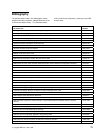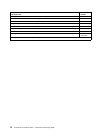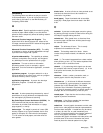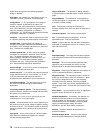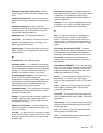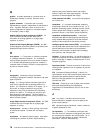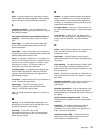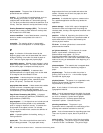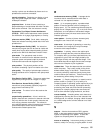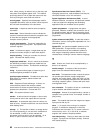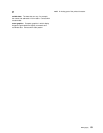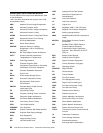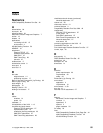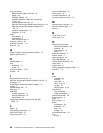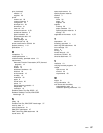used by a printer can be affected by factors such as
printable area and forms orientation.
portrait orientation. Pertaining to a display or hard
copy with greater height than width. Contrast with
landscape orientation
.
preprinted form. A sheet of forms containing a
preprinted design of constant data with which variable
data can be combined. See also
electronic overlay
.
Presentation Text Object Content Architecture
(PTOCA). OPDS control sequences used to present
text information on a page, page segment, or overlay.
print-error marker (PEM). Small, black, rectangular
marks that indicate incorrectly placed data in the valid
printable area.
Print Management Facility (PMF). An interactive
menu-driven program that can be used to create and
modify fonts and to define output formatting for data
printed on the IBM 3130 Advanced Function Printer.
print mode. The operational mode in which
information is received from the attached controlling
computer system and printed output is produced.
Contrast with
test mode
and
diagnostic mode
.
print position. The physical positions of the
characters constituting a print line relative to the form.
print quality. The quality of printed output relative to
existing standards and in comparison with jobs printed
earlier.
Print Service Facility (PSF). The access method that
supports the printing of text an images on a page.
Print Services Access Facility (PSAF). A
menu-driven, print-parameter selection program for
page printers controlled by PSF.
print surface. The side of a form that receives the
printed image.
proportionally-spaced font. A font in which the
graphic characters are contained in character cells that
may vary with the size of each graphic character and
have varying character increments. This allows for
even spacing between printed characters and eliminates
excess white space around narrow characters.
Contrast with constant spaced font.
R
random-access memory (RAM). A storage device
into which data is entered and from which data is
retrieved in a non-sequential matter.
raster. (1) In computer graphics, a predetermined
pattern of lines that provides uniform coverage of a
display space. (2) The coordinate grid that divides the
display area of a display device. (3) In the 3130 Printer
Subsystem, an on/off pattern of electrostatic images
produced by the laser print head under control of the
character generator.
raster pattern. A series of picture elements (pels)
arranged in scan lines to form an image.
raster scan. A technique of generating or recording
the elements of an image by a line-by-line sweep
across the entire output medium.
registration. In printing, refers to the relative print
positions of images that are printed at different times.
For example, when you process preprinted forms, the
registration is good if the new image printed by the
3130 aligns correctly with the preprinted image. Print
that extends beyond box edges and text that overlaps
other text are examples of poor registration.
resident font. Those font data sets that are resident
within the printer. They usually reside on the printer
diskette media (floppy or hard disk). These font sets
are usually commonly used fonts and by having them
resident reduces font load time. These fonts may also
be used during offline testing of the printer.
resource. (1) People, equipment, or material used to
perform a task or a project. (2) Any facility of a
computing system or operating system required by a job
or task, including main storage, input/output devices,
processing units, data sets, and controller processing
programs; for example, page printers use resources
such as form definitions, page definitions, and fonts.
reverse heading. A heading where each character is
highlighted by reversing the color of the character with
its background; for example, changing a black character
on a white background to a white character on a black
background.
S
scanner. A device that examines OCR, graphics,
MICR, or bar-code patterns and generates electrical
signals corresponding to the pattern. It sends the
signals to a computing device for processing.
screen or screening. In document printing, a sheet of
material, usually film, carrying a regular pattern of small
Bibliography 81



